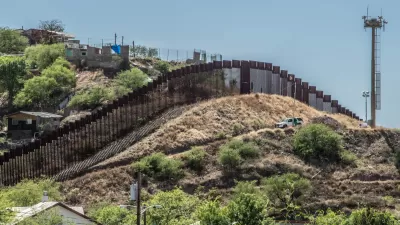Public-private partnerships between local governments and private contractors have the Trump Administration's favor. But in a "P3 market in its infancy," can they cut costs or simply line pockets?

Cited by the Trump Administration as an effective means to build out infrastructure, public-private partnerships let local governments work directly with private companies. Not to be confused with public-private initiatives of the philanthropic variety, "PPPs" or "P3s" prompt a lot of debate.
Matthew Goldstein and Patricia Cohen write: "Companies can complete projects quicker and more cheaply than governments can, proponents say. Letting private industry take the lead can also limit the amount of debt that cities and states need to take on."
Overall, the authors appear unconvinced. "And whatever the advantages of giving the private sector a stake in public works — rather than leaving the government in control — experts agree that while some public-private partnerships may result in near-term savings, there is little hard evidence that they perform better over time."
Cohen and Goldstein note that P3 deals are more common in Canada and overseas due to a bigger municipal bond market in the United States (and a correspondingly smaller P3 market). The worry is that if they're implemented more often in this country, P3s will fail to cut costs, instead transferring them to the public via long-term contracts.
FULL STORY: Public-Private Projects Where the Public Pays and Pays

Planetizen Federal Action Tracker
A weekly monitor of how Trump’s orders and actions are impacting planners and planning in America.

Chicago’s Ghost Rails
Just beneath the surface of the modern city lie the remnants of its expansive early 20th-century streetcar system.

San Antonio and Austin are Fusing Into one Massive Megaregion
The region spanning the two central Texas cities is growing fast, posing challenges for local infrastructure and water supplies.

Since Zion's Shuttles Went Electric “The Smog is Gone”
Visitors to Zion National Park can enjoy the canyon via the nation’s first fully electric park shuttle system.

Trump Distributing DOT Safety Funds at 1/10 Rate of Biden
Funds for Safe Streets and other transportation safety and equity programs are being held up by administrative reviews and conflicts with the Trump administration’s priorities.

German Cities Subsidize Taxis for Women Amid Wave of Violence
Free or low-cost taxi rides can help women navigate cities more safely, but critics say the programs don't address the root causes of violence against women.
Urban Design for Planners 1: Software Tools
This six-course series explores essential urban design concepts using open source software and equips planners with the tools they need to participate fully in the urban design process.
Planning for Universal Design
Learn the tools for implementing Universal Design in planning regulations.
planning NEXT
Appalachian Highlands Housing Partners
Mpact (founded as Rail~Volution)
City of Camden Redevelopment Agency
City of Astoria
City of Portland
City of Laramie





























